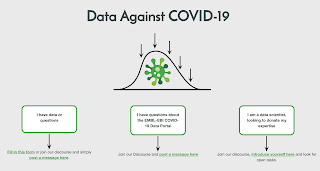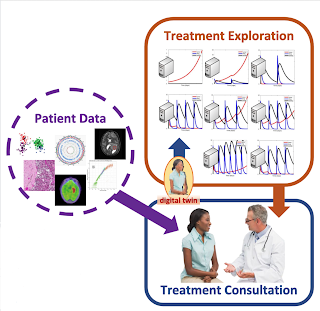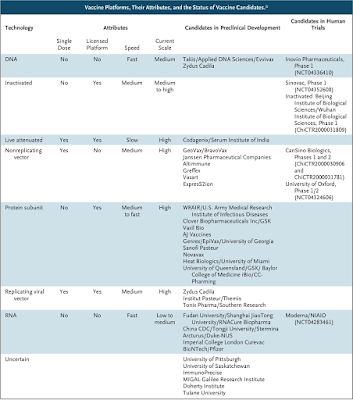Not all news about COVID-19 is bad -- as a data scientist, here is what you can do to help
"Life will not be contained....life will find a way" so aptly said by Dr. Ian Malcolm, a fictional character who is a mathematician specializing in Chaos theory in the 1993 movie Jurassic Park, has a new meaning for all of us during these times of the COVID-19 pandemic.
Even though we are surrounded by fear, anxiety and confusion around how bad this pandemic will get and how long until we are free to live our lives as we did before the pandemic, I am confident that together, we will find a way. There are many reasons for hope and optimism and here is why:
- Treatments are starting to show benefit. The US Food and Drug Administration has approved the use of plasma from recovered patients to treat people who are critically ill with COVID-19; while clinical trials are needed, this treatment had dramatic improvement in ventilator-dependent COVID-19 patients. While still anecdotal and requires well-controlled clinical trials, there is some evidence that Malaria drugs, Chloroquine and hydroxychloroquine have been found to be effective in patients with SARS-CoV-2, the virus causing COVID-19.
- Vaccine candidates are promising. Scientists have developed a potential vaccine against SARS-CoV-2, which when tested in mice, produces antibodies at quantities sufficient enough to neutralize the virus. While human testing is still pending, this SARS-CoV-2 micro-needle vaccine maintains its potency even after being thoroughly sterilized with gamma radiation which is a key step toward making a vaccine that is suitable for use in humans.
- The worst may be over for many. In Italy, the epicenter of COVID-19, the worst may be over; number of new infections has plateaued giving everyone a glimmer of hope. Here is a hopeful chart showing a decline in daily deaths in Lombardy, Italy. The discussions are slowly shifting from lockdowns, ventilators, hospital beds and PPE deficiencies to when and how to thoughtfully reopen. This is a good problem to have now. If we can rapidly measure the right antibodies against this Coronavirus in one's blood, we may be able to determine who is free to move around without any fear of spreading the virus to others. Diagnostic companies are already beginning to develop such test kits.
- We have the Internet. Many of us are able to conduct our business using Zoom, WebEx or other web conferencing tools and "see" our loved ones living far away via FaceTime and WhatsApp video apps. We have close-to-realtime access to reliable stats on COVID-19 data from CDC and WHO and projection models to help resource planning at hospitals.
- Most people with COVID-19 have recovered. While the loss of life to this virus has been terrible, the overall case fatality rate in people less than 60 years of age is less than 1% which is much lower compared to other deadly viruses such as Ebola (90%), SARS (11%) and MERS (34%).
As data scientists, we have many opportunities to contribute to this hope and optimism against COVID-19 in a reliable, data-driven fashion. Here are five ways in which you can participate.
1. Data against COVID-19. Join hands with 100's of clinicians, epidemiologists, life scientists, machine learners, programmers, and statisticians to conduct COVID-related research. You can report information on cases, upload/use data resources on COVID or donate your data science expertise to clinicians and scientists who are working on home monitoring systems in Spain, collecting diagnostic test results from patients in UK, vulnerable populations in Africa among many other open science projects.
 |
|
2. Crowd fight COVID. Sign up for this matchmaking service which connects researchers around the world to highly skilled scientists who are volunteering their time and expertise to join the fight against COVID-19. Through this online platform, researchers can state their wish/task and a coordinator will connect the researcher to a skilled talent pool to solve the problem. Tasks range from annotating images, conducting QC on data from automatic pipelines to finding reagents and finding nearby BSL-3 labs that can handle serious or lethal pathogens like SARS-CoV-2.
|
 |
https://crowdfightcovid19.org/ |
3. An evolving scientific review of COVID-19 diagnostics and therapeutics. Participate in an online, collaborative review relevant to the development of diagnostics and therapeutics for COVID-19. With the rapidly evolving global situation related to COVID-19, the infectious disease caused by the SARS-CoV-2 virus, there is a need to centralize this scientific knowledge. Participate in the creation of this repository of knowledge by reviewing and commenting on literature published from clinical studies on COVID-19 and SARS-CoV-2 virus.
4. COVID-19 Open Research Dataset Challenge (CORD-19). Use this freely available dataset that the White House, Allen institute for Artificial Intelligence and a coalition of leading research groups have prepared to apply recent advances in natural language processing and other AI techniques to generate new insights in support of the ongoing fight against this infectious disease. CORD-19 is a resource of over 47,000 scholarly articles, including over 36,000 with full text, about COVID-19, SARS-CoV-2, and related coronaviruses. 10 different tasks have been posted on this challenge to help us better understand risk factors, genetics, diagnostics, vaccines, clinical care, ethical and social issues for combating COVID-19.
5. Pandemic Data Room. QED has partnered with Georgetown University and others to create data solutions to help fight COVID-19. Unique data are being aggregated by consortium members from resources around the world to understand social behavior. Deploying a combination of SMS- and internet-based surveys, the team is collecting data on behaviors that are protective against COVID19 transmission and assess how country populations are complying with physical distancing and hygiene requirements. These and other curated datasets will be used in a data challenge to be launched in mid-April to answer important questions about social behavior such as - 1) Are the public following physical distancing directives? If so, is this consistently being followed? 2) What is the public’s knowledge of COVID-19 transmission? 3) What has been the impact of physical distancing on employment, childcare, and everyday activities? 4) Are people practicing basic hygiene? 5) Given levels of physical distancing – will this be sufficient to flatten the curve? and many others. Watch QED's Center for Global Data Visualization for announcements regarding this data challenge.
As Bill Gates wrote in his call to action to our leaders, "if we make the right decisions now, informed by science, data, and experience of medical professionals, we can save lives and get the country back to work."
We must be sure to continue to do our part by following guidelines for social distancing and mitigation strategies so that we can get through this global crisis together.
We must be sure to continue to do our part by following guidelines for social distancing and mitigation strategies so that we can get through this global crisis together.




Comments
Post a Comment